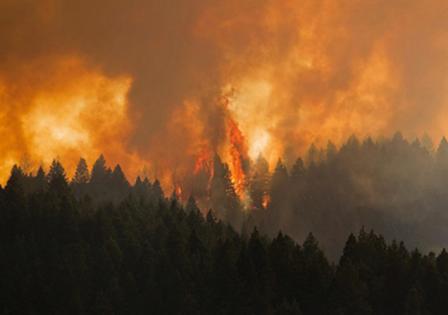California Prepares for Increased Wildfire Risk to Air Quality From Climate Change
 Wildfires, a longstanding and frequent threat to California, are expected to increase in intensity and frequency due to climate change. While wildfires are obviously a significant threat to property and public safety, they can also significantly affect air quality by increasing the amount of particulates in the air. Because of this, California included wildfire threat within its 2009 Climate Adaptation Strategy and seeks to reduce and adapt to the increasing future threat to air quality from wildfires.
Wildfires, a longstanding and frequent threat to California, are expected to increase in intensity and frequency due to climate change. While wildfires are obviously a significant threat to property and public safety, they can also significantly affect air quality by increasing the amount of particulates in the air. Because of this, California included wildfire threat within its 2009 Climate Adaptation Strategy and seeks to reduce and adapt to the increasing future threat to air quality from wildfires.
Consistent with adaptation planning practices, California conducted a vulnerability assessment to better understand the projected magnitude of impact climate change could have on wildfire activity including concerns such as the effectiveness of California's climate sinks (i.e., carbon stored in vegetation) and how projected climate changes are expected to impact them. While there are many factors that may influence the past trends, climate change is expected to significantly impact California's forests and contribute to an increase of wildfires in the projected future.
California's 2010 Rangeland Assessment’s chapter on climate change notes that the fire season has been starting sooner and ending later, and the severity of wildfire acreage burned has been increasing in recent years. The Rangeland Assessment also includes reference to literature (i.e., studies) that suggests the increased number of wildfires will lead to a corresponding increase in the number of ‘bad’ air days from particulate matter. California is anticipating how climate change will affect wildfires and associated public health concerns and adapting by protecting forests, increasing public awareness of proper land management strategies, and promoting efforts to better maintain air quality.
- 2009 Climate Adaptation Strategy (PDF) (200 pp, 4.2 MB, About PDF) Exit
- Rangeland Assessment Exit
| How Did They Do It? | Applicable EPA Tools |
|---|---|
Assessed public health risk from increased wildfires due to changing climate conditions
|
Review the 2014 Quadrennial Fire Review (PDF) (96 pp, 4.4 MB) to evaluate the strategic outlook of wildland fire management over the next 10-20 years and use EPA’s Wildfire Smoke Guide for Public Health Officials to identify potential impacts to public health. |
Identified adaptation strategies and created local resources
|
Use the Forest Service’s LANDFIRE (Landscape Fire and Resource Management Planning Tools) to map vegetation, fire, and fuel characteristics at a landscape scale to support resource management initiatives. * (This is a non-EPA resource from the U.S. Forest Service.) |
Similar Cases and More Information
Wildfires pose extreme threats to public safety, however this case focuses on EPA's role, in this case, protecting air quality. For more information on wildfires, including the impact to human health and safety, please visit the National Climate Assessment or U.S. Resiliency Toolkit. For another example on how a community is adapting to air quality concerns see the Salt Lake City case.
References
- Climate Change And Wildfire in and Around California: Fire Modeling and Loss Modeling (PDF) (33 pp, 2.3 MB) Exit
- Climate Change: Threats and Opportunities (PDF) (10 pp, 347 K) Exit
- Chapter 3.7 Climate Change: Threats and Opportunities (PDF) (22 pp, 5 MB) Exit
- California Adaptation Planning Guide: Defining Local & Regional Impacts (PDF) (94 pp, 5.8 MB) Exit
- California Adaptation Planning Guide: Planning for Adaptive Communities (PDF) (60 pp, 7 MB) Exit
- 2009 California Climate Adaptation Strategy (PDF) (200 pp, 4.2 MB) Exit

